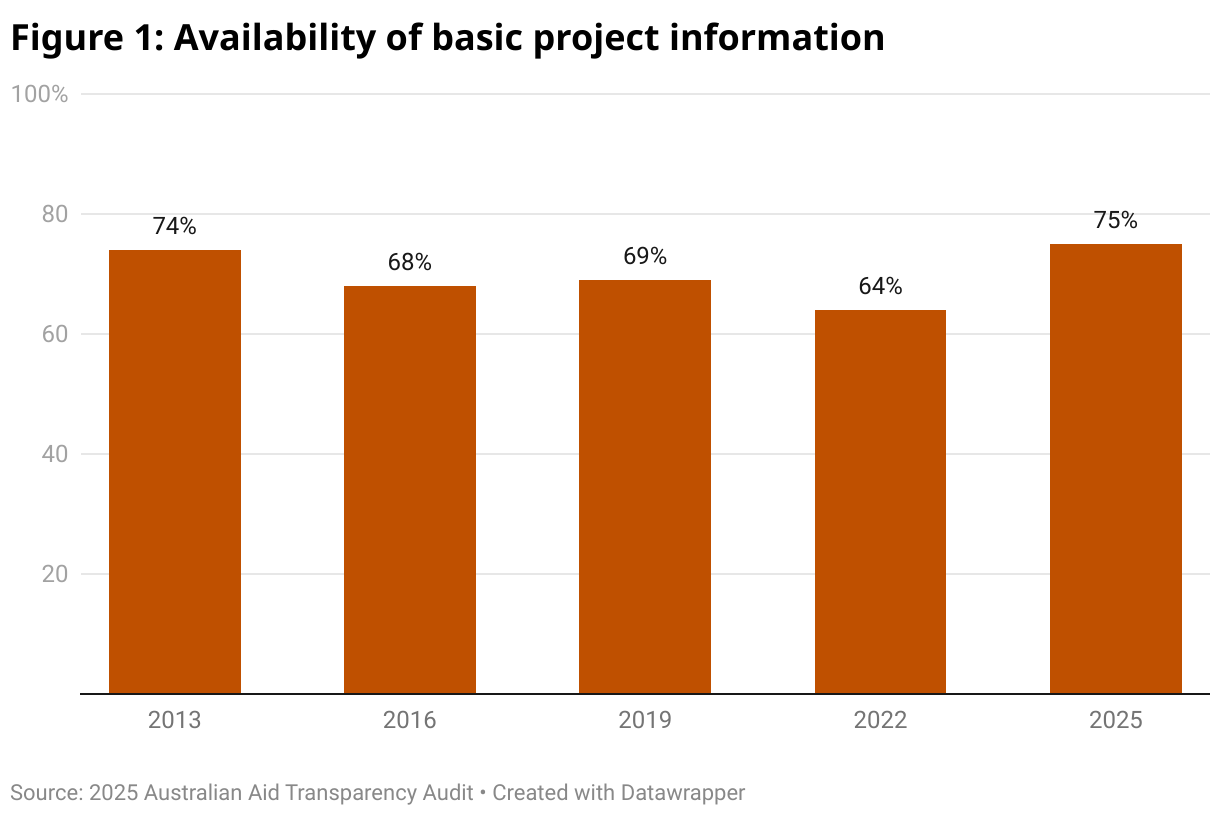How transparent is Australian aid?
August 14, 2025
Aid, by its very nature, is harder to monitor than domestic spending. This makes transparency integral to good aid practice. Transparency makes it easier for the donor public to track how their taxes are being spent.
Transparency also makes it easier for people in aid recipient countries to learn about the aid affecting them. The Development Policy Centre has been auditing the transparency of the Australian Government aid program every three years since 2013. Today we are launching the 2025 Development Policy Centre Australian Aid Transparency Audit.
The 2025 Audit covers many different aspects of aid transparency. We assessed the high-level information the aid program makes available on the aid budget each year. We assessed whether the aid program makes project performance data easy to find. We also assessed whether basic project information such as budgets and locations is available for all projects. And we covered whether the aid program puts detailed documentation online for larger projects.
The 2025 Audit brings good news: since 2013, Australian aid transparency had been deteriorating. Not so anymore. In 2025, Australian aid transparency improved considerably. These improvements were driven, first and foremost, by Australia’s new AusDevPortal.
The portal contains high-level information on Australian aid such as overall aid spending and sectoral spends. It also lists all aid projects and provides basic information ranging from project spending to project performance (for projects large enough to have their performance assessed). The portal also contains links to some, but not all, of the important project documentation we assessed.
There are areas for improvement. At present the portal contains limited time series data (something that will hopefully improve as more years’ data are added to the portal). At this point in time, the portal does not allow users to easily download data, which is a problem for anyone wishing to undertake systematic analysis. The portal is also not yet a one-stop shop for aid project documentation. Some documentation is simply not online; other documents aren’t on the portal, but they can be found with digging elsewhere.
The impact of the portal on basic project information is shown in the chart below. This type of information is now more available than at any time since our audits began. The score for 2025 would have been 100% had the 2023-24 data been uploaded at the time the Audit was conducted. This would have ensured there was previous years’ expenditure available for projects. Future years will likely hit this mark.

Source: 2025 Australian Aid Transparency AuditGet the data Download imageCreated with Datawrapper
The availability of detailed project documentation has been a weakness identified in several Transparency Audits. The problem was particularly acute at the time of the 2022 Audit. Here too, the 2025 Audit brought good news: the trend of deteriorating document transparency has reversed. Overall document transparency in 2025 was notably better than in 2022. This improvement was driven by the improved availability of review and evaluation documents, and implementation documents. However, the availability of planning and design, and policy and direction documents, on the other hand, has not improved. As a result, overall document transparency is not yet as high as it was in years prior to 2022 and remains an issue of concern.
It’s a concern that doesn’t plague all of the aid program equally. In 2025, as in previous audits, document availability varied considerably between different country and regional programs. There were other patterns visible in the 2025 documentation data too. Of most importance, in 2025, as in earlier years, we found that projects that started the project cycle more transparently were more likely to remain transparent across the project cycle.
Based what we found in 2025, we have made the following transparency recommendations for the Australian aid program.
Keep doing the good things. Australia now performs well in a range of aspects of transparency, from the provision of high-level aid budget information to individual project data. Our first recommendation is simply that the aid program ought to continue ensuring these successes are maintained in the future.
Maintain and grow AusDevPortal. The portal has been the most significant improvement in Australian aid transparency over the 12-year period that we have conducted Transparency Audits. In coming years, it will be crucial that the portal continues to be regularly updated with data and that its functions are expanded to include tools such as data downloads. The portal has been a real achievement. Now the aid program needs to make sure the portal is maintained and improved upon.
Improve document availability. Although there have been some improvements, the availability of project documentation remains a weakness. As such, an urgent recommendation of this audit is that resources and effort need to be devoted to ensuring that the availability of project documentation improves.
Enabling environment. First and foremost, the source of Australia improving its aid transparency has been the DFAT staff who have worked on the portal, as well as their colleagues who have provided information to the portal team. However, support from politicians and senior DFAT staff was also a crucial driver of the transparency improvements we found in 2025. If the portal is to be maintained and grown in the future, senior DFAT officials and politicians will need to continue to resource and empower those working on Australian aid transparency. For this reason, our final recommendation is that politicians and DFAT officials continue their high-level support of Australian aid transparency.
The 2025 Audit has documented a real improvement in Australian aid transparency. The challenge now will be to ensure that these gains endure and are built upon.
The 2025 Australian Aid Transparency Audit is available to download.
Download PDFDisclosure This research was undertaken with the support of the Gates Foundation. The views represent those of the authors only.
Republished from DevPolicy Blog, 12 August 2025
The views expressed in this article may or may not reflect those of Pearls and Irritations.
